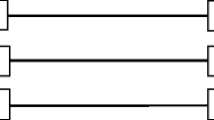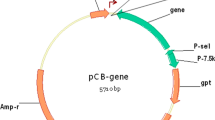Abstract
Multigene-based combination therapy is an effective practice in cancer gene therapy. Apoptin is a chicken anemia virus-derived, p53-independent, Bcl-2-insensitive apoptotic protein with the ability to specifically induce apoptosis in various human tumor cells. Interleukin-24 (IL-24) displays ubiquitous antitumor property and tumor-specific killing activity. Adeno-associated virus (AAV) is a promising gene delivery vehicle due to its advantage of low pathogenicity and long-term gene expression. In this study, we assessed the efficacy of combination therapy using AAV-mediated co-expression of apoptin and interleukin-24 on hepatocellular carcinoma in vitro and in vivo. Our results showed that AAV-mediated co-expression of IL-24 and apoptin significantly suppressed the growth and induced the apoptosis of HepG2 cells in vitro. Furthermore, AAV-mediated combined treatment of IL-24 and apoptin significantly suppressed tumor growth and induced apoptosis of tumor cells in xenograft nude mice. These data suggest that AAV vectors that co-express apoptin and IL-24 have great potential in cancer gene therapy.





Similar content being viewed by others
References
Parkin DM, Bray F, Ferlay J, et al. Global cancer statistics, 2002. CA Cancer J Clin. 2005;55:74–108.
Roberts LR. Sorafenib in liver cancer—just the beginning. N Engl J Med. 2008;359:420–2.
Roayaie S, Blume IN, Thung SN, et al. A system of classifying microvascular invasion to predict outcome after resection in patients with hepatocellular carcinoma. Gastroenterology. 2009;137:850–5.
Newell P, Villanueva A, Llovet JM. Molecular targeted therapies in hepatocellular carcinoma: from pre-clinical models to clinical trials. J Hepatol. 2008;49:1–5.
Yang CL, Jiang FQ, Xu F, Jiang GX. ADAM10 overexpression confers resistance to doxorubicin-induced apoptosis in hepatocellular carcinoma. Tumour Biol. 2012;33:1535–41.
Kaliberova LN, Krendelchtchikova V, Harmon DK, et al. CRAdRGDflt-IL-24 virotherapy in combination with chemotherapy of experimental glioma. Cancer Gene Ther. 2009;16:794–805.
Zerbini LF, Tamura RE, Correa RG, et al. Combinatorial effect of non-steroidal anti-inflammatory drugs and NF-kappaB inhibitors in ovarian cancer therapy. PLoS One. 2011;6:e24285.
Patani N, Douglas-Jones A, Mansel R, et al. Tumour suppressor function of MDA-7/IL-24 in human breast cancer. Cancer Cell Int. 2010;10:29.
Zhu Y, Lv H, Xie Y, et al. Enhanced tumor suppression by an ING4/IL-24 bicistronic adenovirus-mediated gene cotransfer in human non-small cell lung cancer cells. Cancer Gene Ther. 2011;18:627–36.
Yan S, Zhang H, Xie Y, et al. Recombinant human interleukin-24 suppresses gastric carcinoma cell growth in vitro and in vivo. Cancer Investig. 2010;28:85–93.
Lebedeva IV, Su ZZ, Sarkar D, et al. Melanoma differentiation associated gene-7, mda-7/interleukin-24, induces apoptosis in prostate cancer cells by promoting mitochondrial dysfunction and inducing reactive oxygen species. Cancer Res. 2003;63:8138–44.
Los M, Panigrahi S, Rashedi I, et al. Apoptin, a tumor-selective killer. Biochim Biophys Acta. 2009;1793:1335–42.
Yuan L, Zhang L, Dong X, Zhao H, Li S, Han D, et al. Apoptin selectively induces the apoptosis of tumor cells by suppressing the transcription of HSP70. Tumour Biol. 2013;34:577–85.
Lin B, Kolluri SK, Lin F, et al. Conversion of Bcl-2 from protector to killer by interaction with nuclear orphan receptor Nur77/TR3. Cell. 2004;116:527–40.
Hanahan D, Weinberg RA. The hallmarks of cancer. Cell. 2000;100:57–70.
Jiang G, Jiang AJ, Cheng Q, et al. A dual-regulated oncolytic adenovirus expressing interleukin-24 sensitizes melanoma cells to temozolomide via the induction of apoptosis. Tumour Biol. 2013;34:1263–71.
Yacoub A, Park MA, Gupta P, et al. Caspase-, cathepsin-, and PERK-dependent regulation of MDA-7/IL-24-induced cell killing in primary human glioma cells. Mol Cancer Ther. 2008;7:297–313.
Acknowledgments
This study was supported by the funds from the Natural Science Foundation of Heilongjiang (QC2011C071), Dr. Wu Liande Fund (WLD-QN1110), and Heilongjiang Science and Technology Project Fund.
Conflicts of interest
None
Author information
Authors and Affiliations
Corresponding authors
Additional information
Lijie Yuan and Hengyu Zhao contributed equally to this study.
Rights and permissions
About this article
Cite this article
Yuan, L., Zhao, H., Zhang, L. et al. The efficacy of combination therapy using adeno-associated virus-mediated co-expression of apoptin and interleukin-24 on hepatocellular carcinoma. Tumor Biol. 34, 3027–3034 (2013). https://doi.org/10.1007/s13277-013-0867-z
Received:
Accepted:
Published:
Issue Date:
DOI: https://doi.org/10.1007/s13277-013-0867-z




